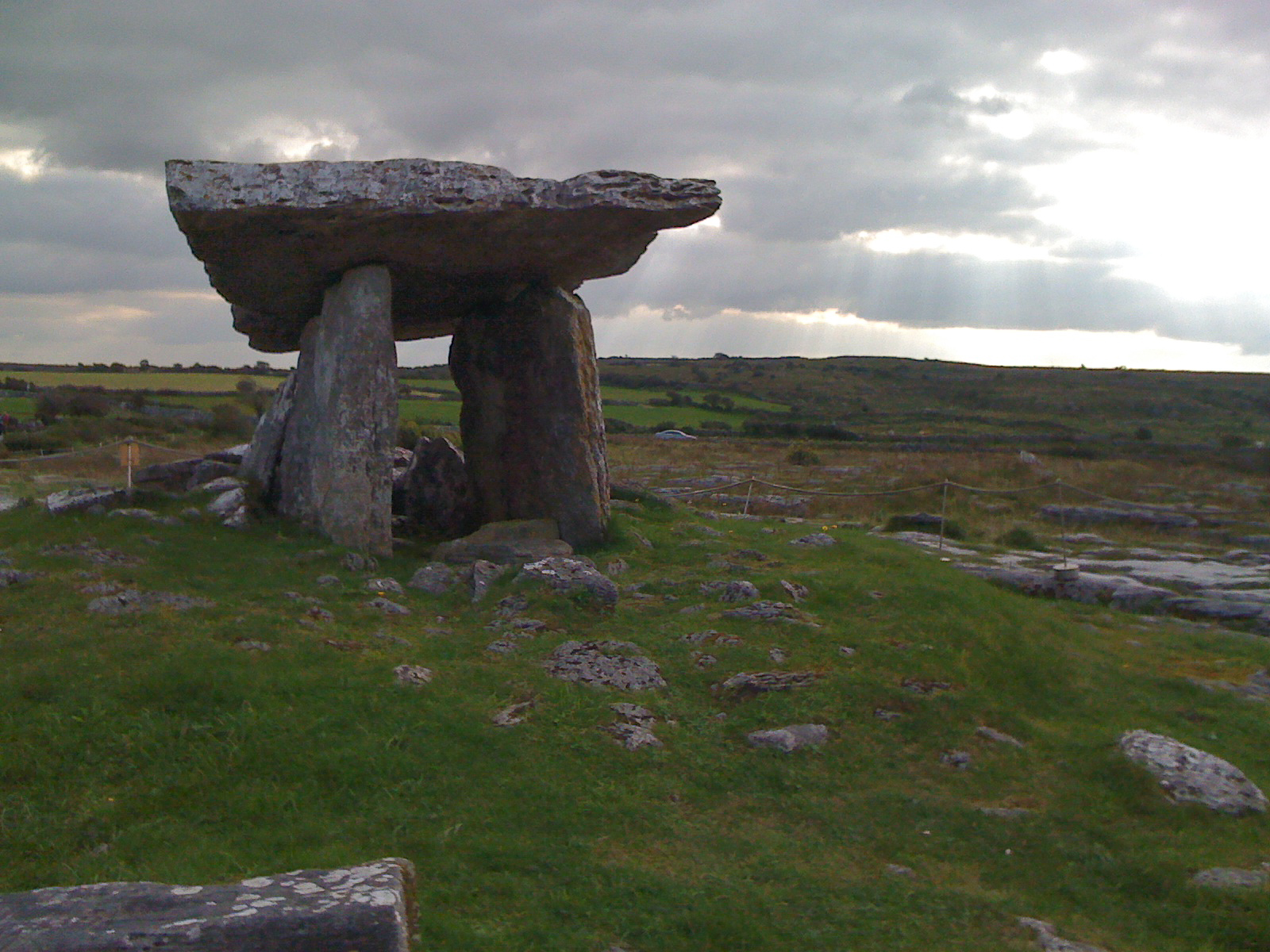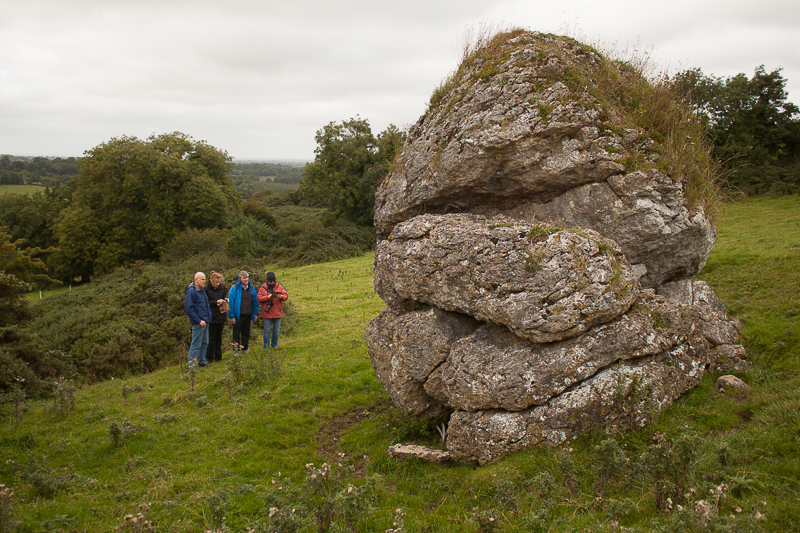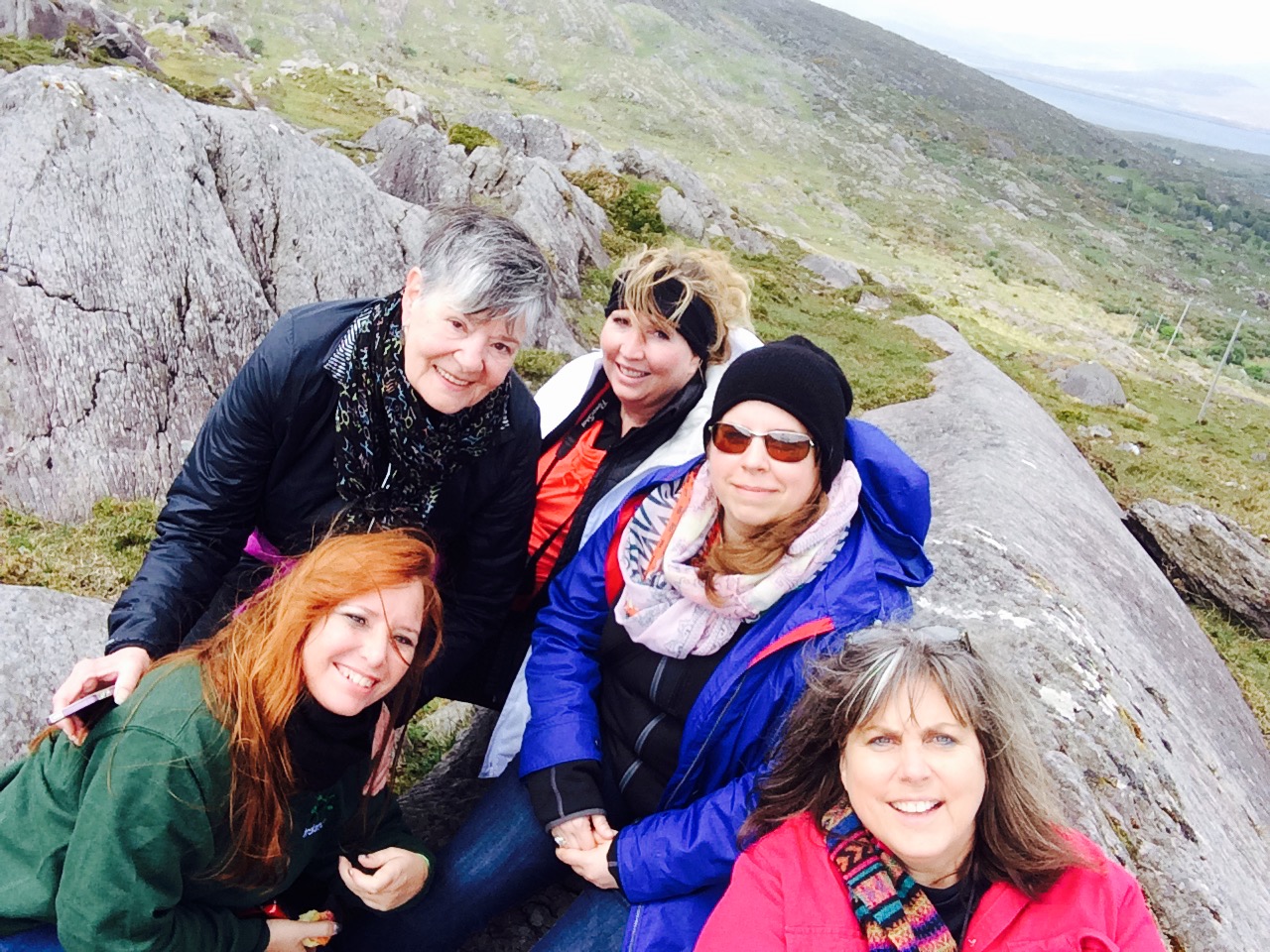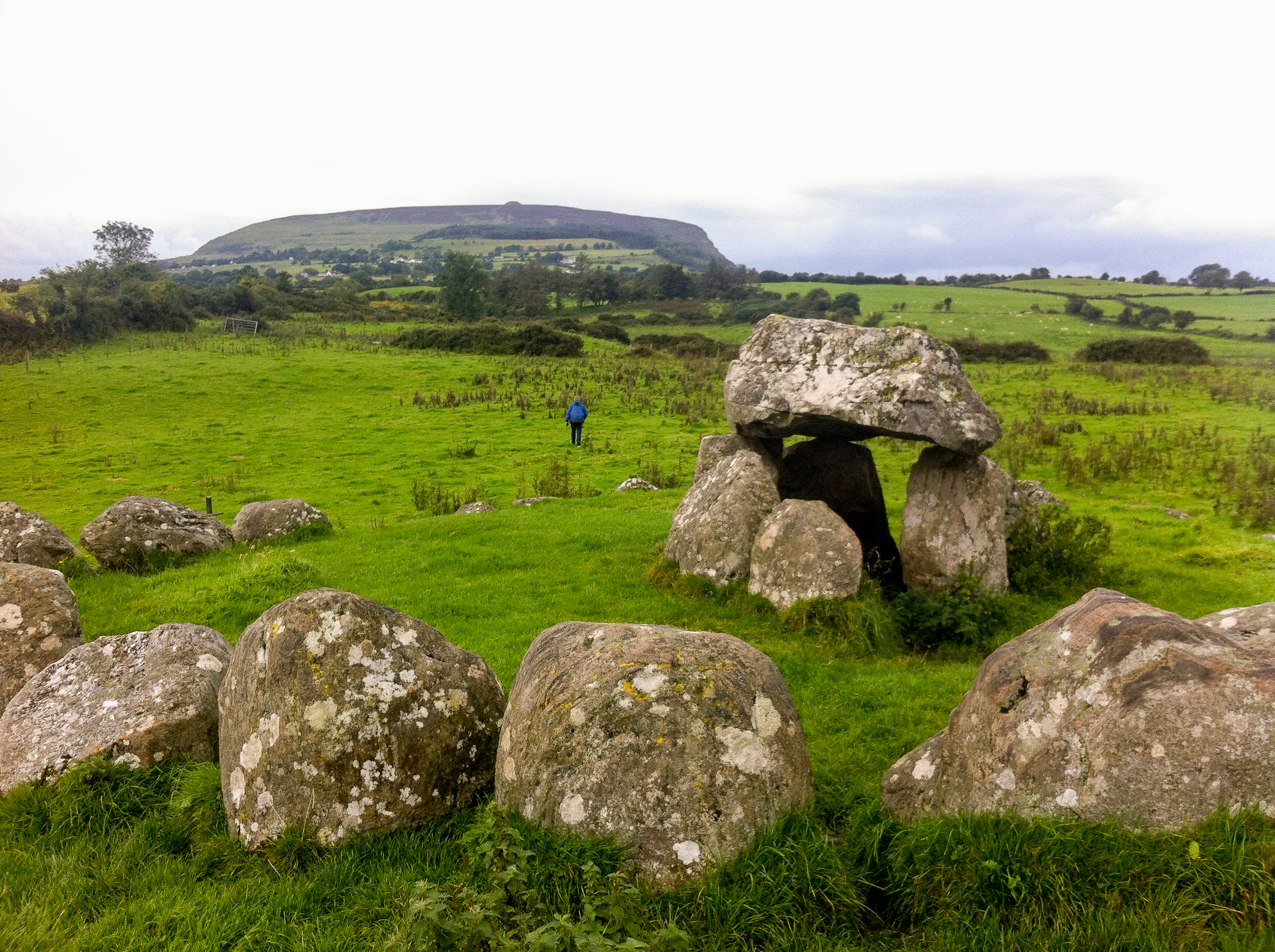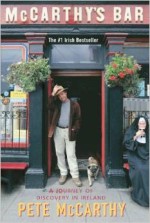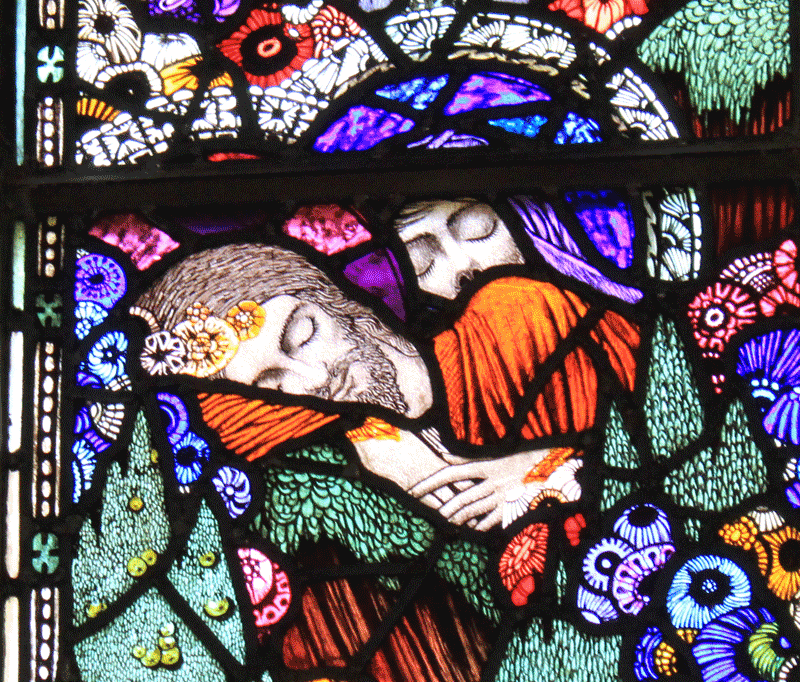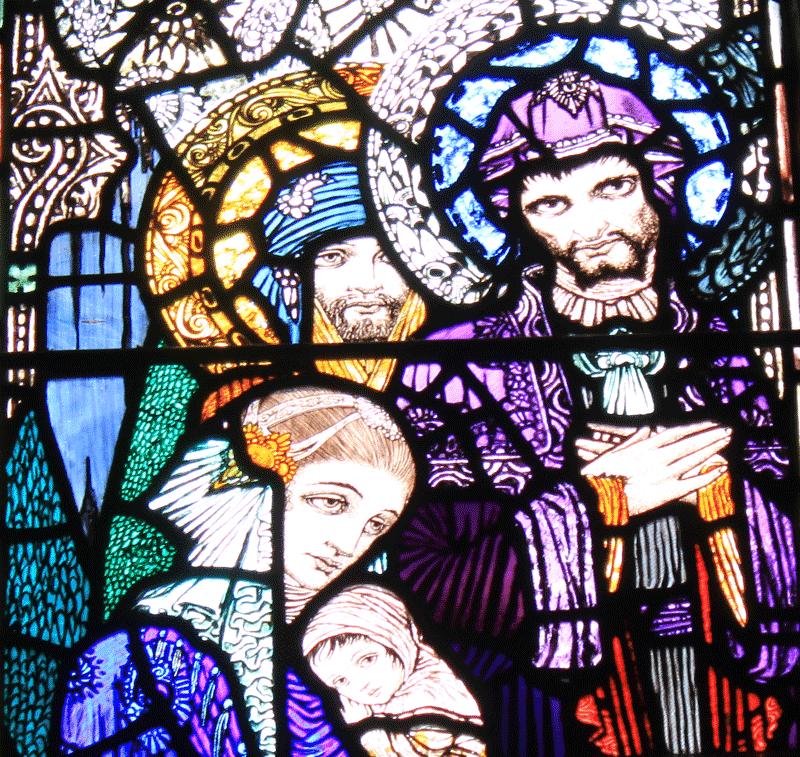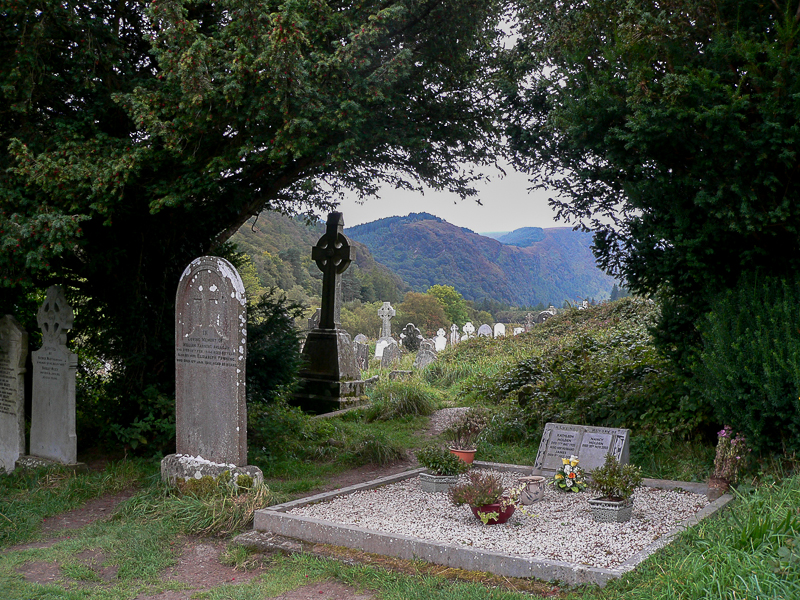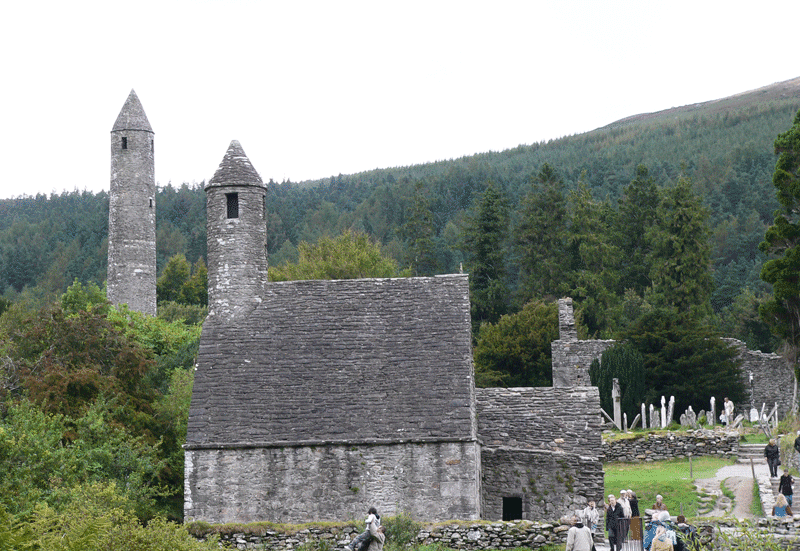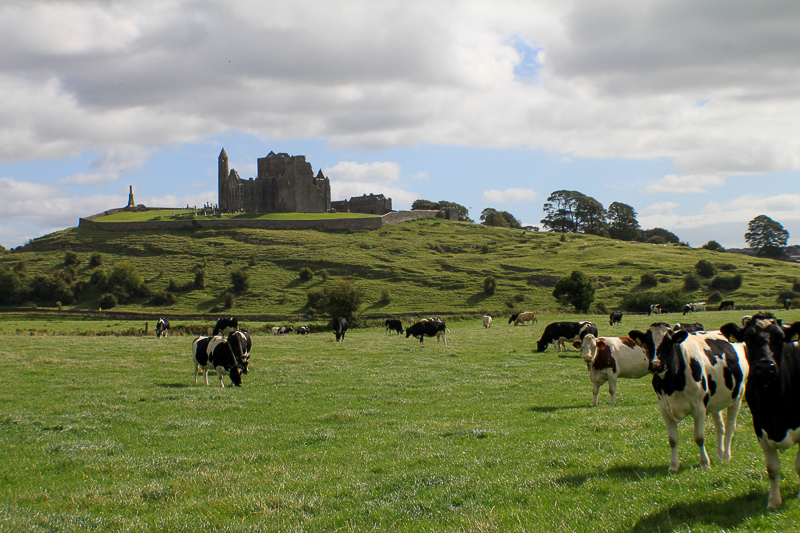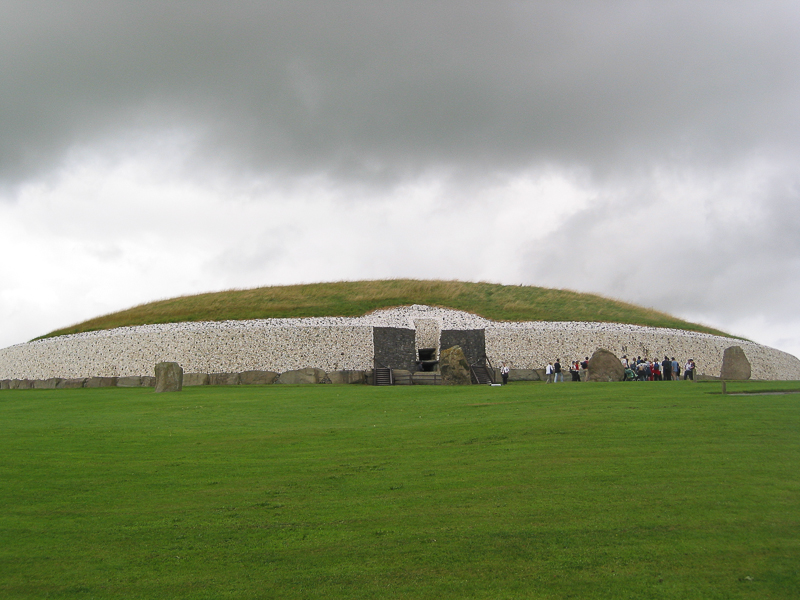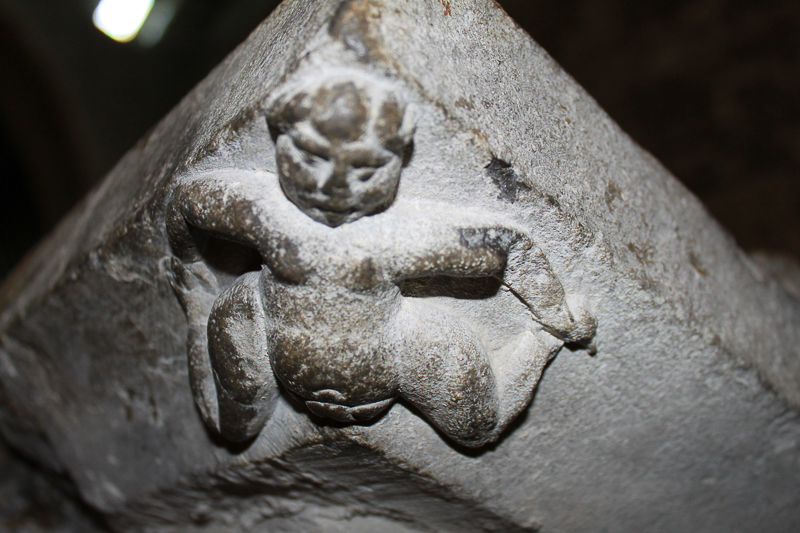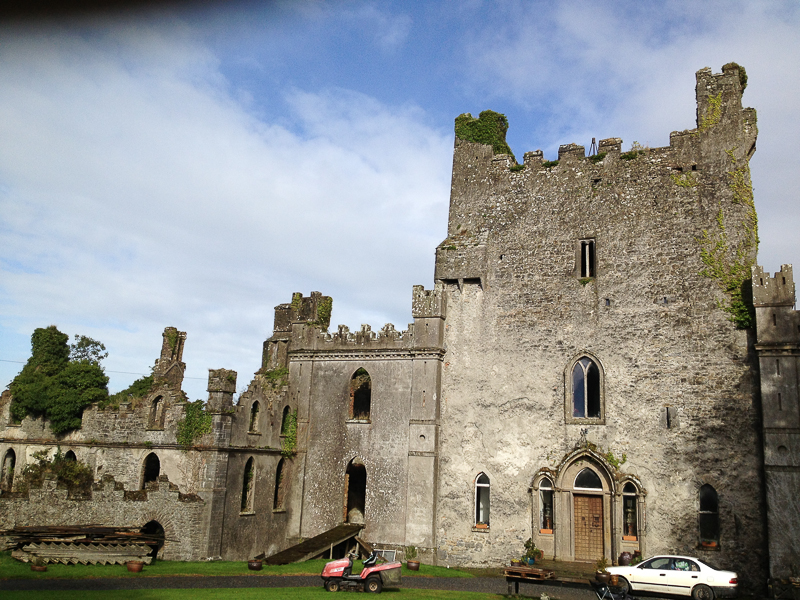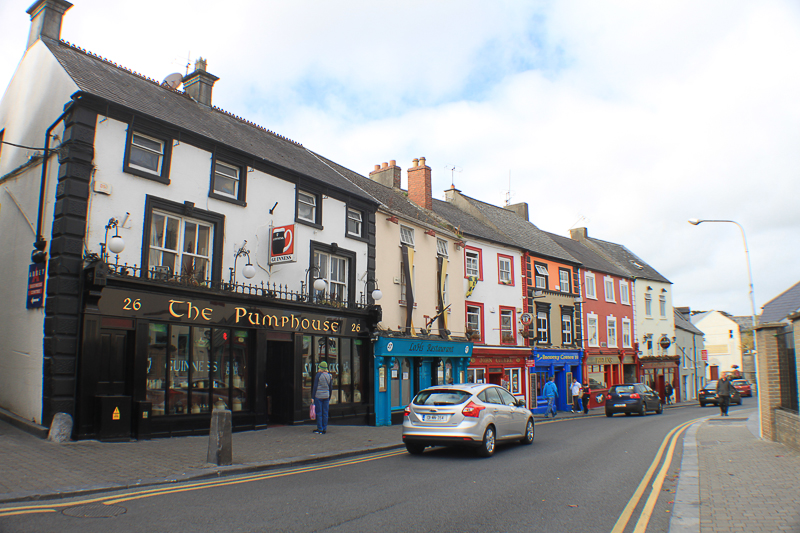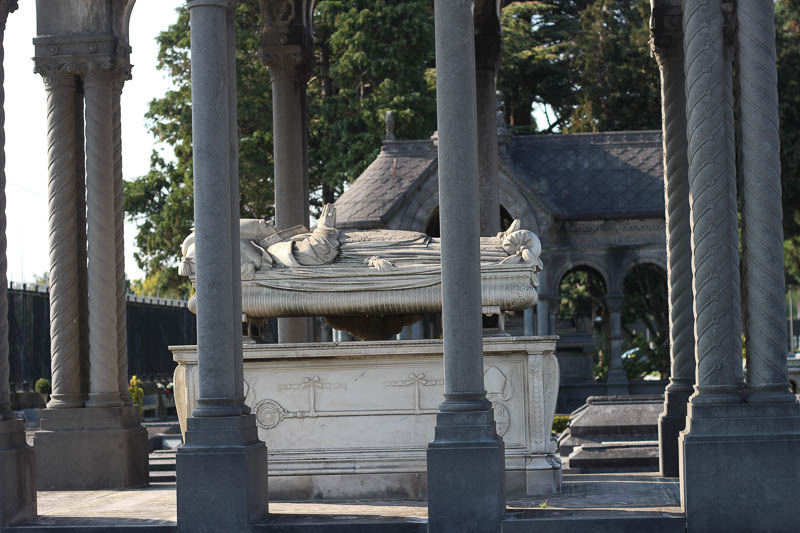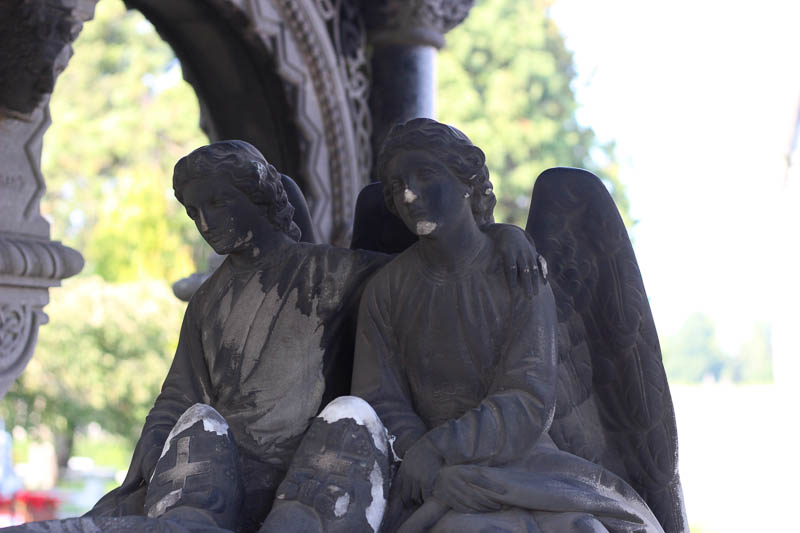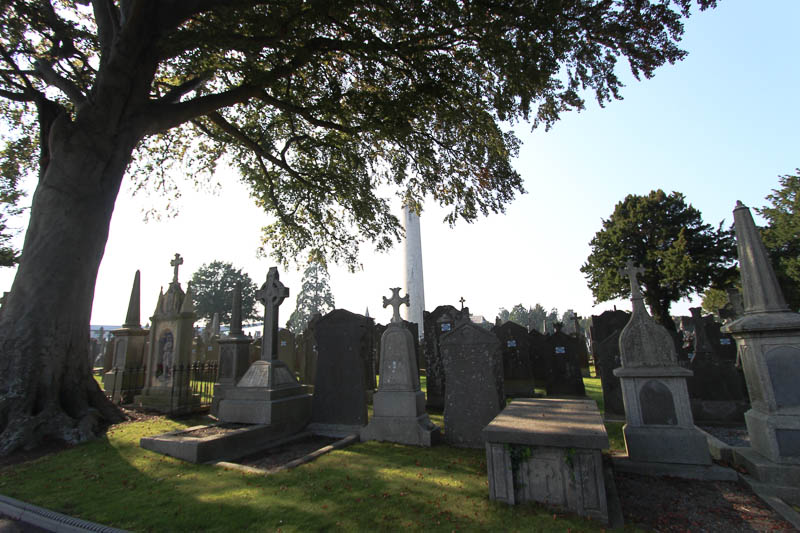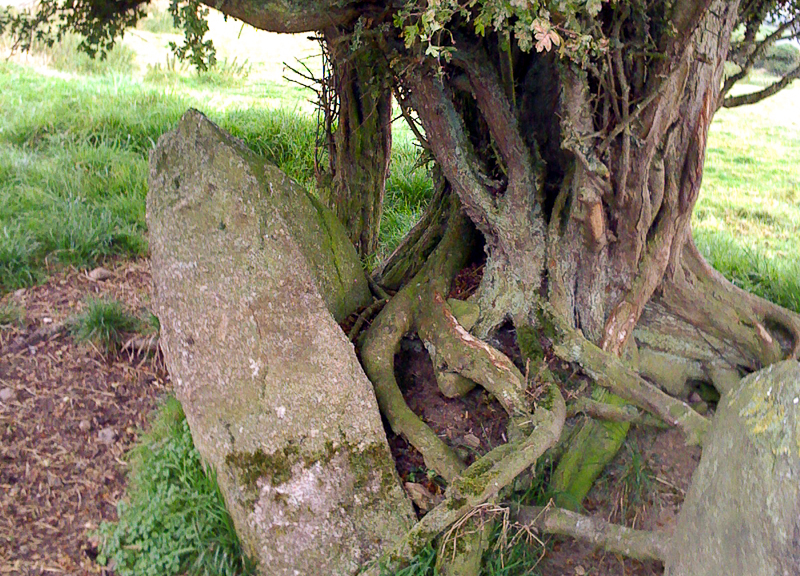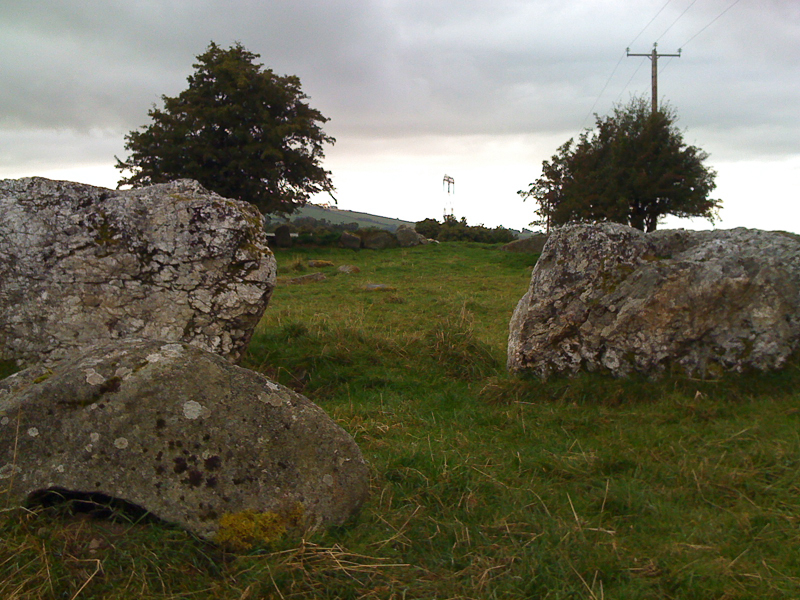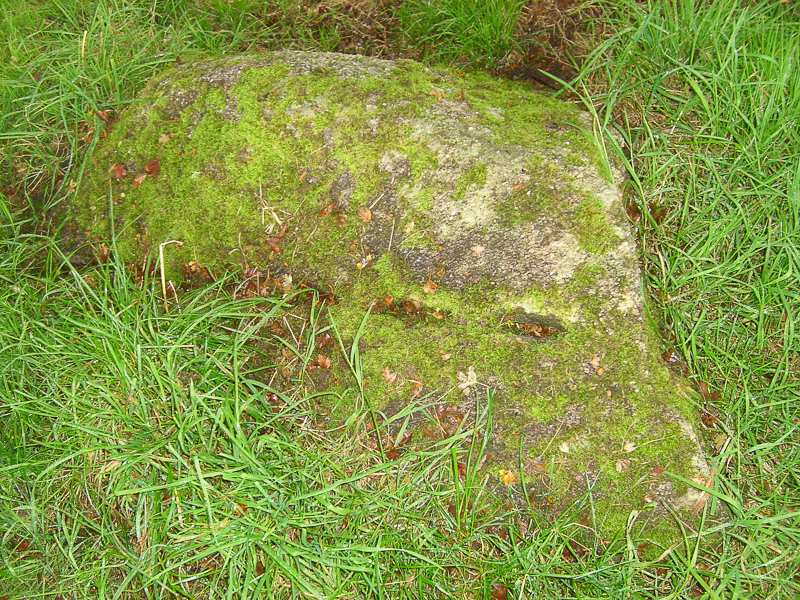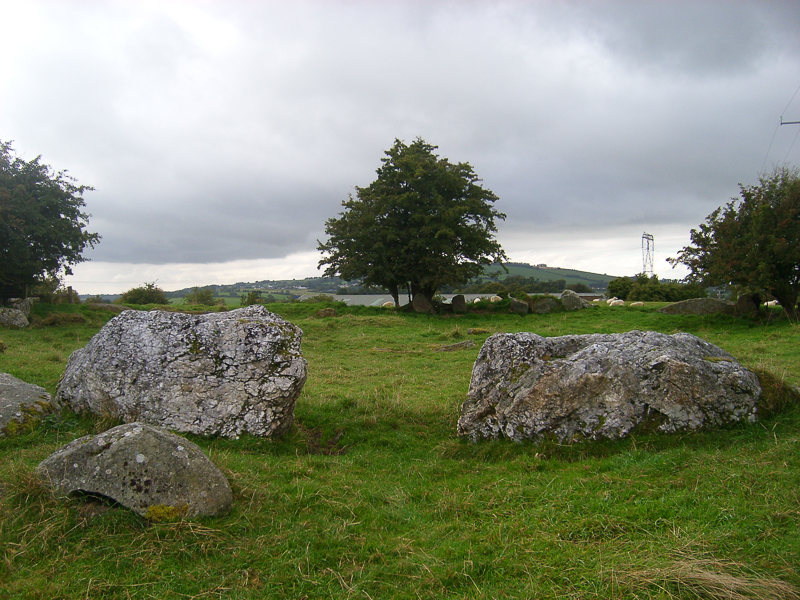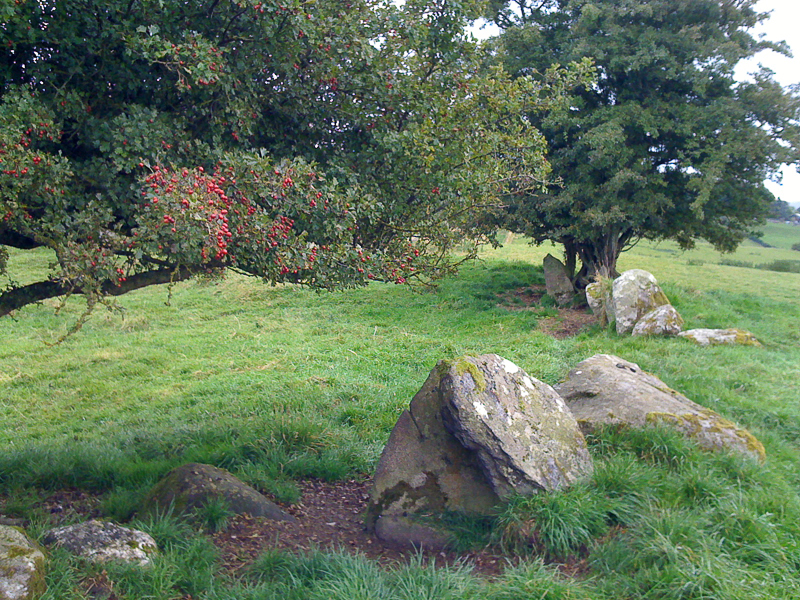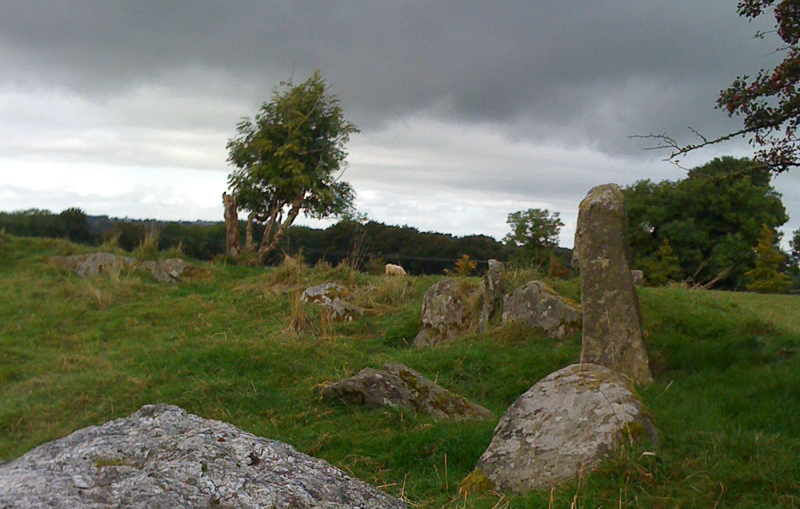Discover the North Tour 2016 Begins with the Blessing of St. Brigid

Statue of St. Brigid at Tobar Bride – St. Brigid’s Holy Well in Kildare
The 2016 Discover the North tour started in Dublin today as our 18 guests arrived at Dublin Airport from many parts of United States and Canada. One of our favorite places to take guests on the first day is to Solas Bhride – a center in Kildare run by Brigidine sisters who provide a warm welcome and the blessing of St. Brigid.

Sr. Phil talks about the tradition of the St. Brigid’s Cross at Solas Bhride
Our guests gathered for the first time as a group today at 1pm for a short meeting. Then we boarded our bus in the rain. It was a damp, dreary day. But the dismal atmosphere lifted when Sister Phil and Sister Mary met at the door of this Christian spirituality center that welcomes people of all faiths and of no faith within the context of the Solas Bhride vision to unfold the legacy of St. Brigid and its relevance for our time.
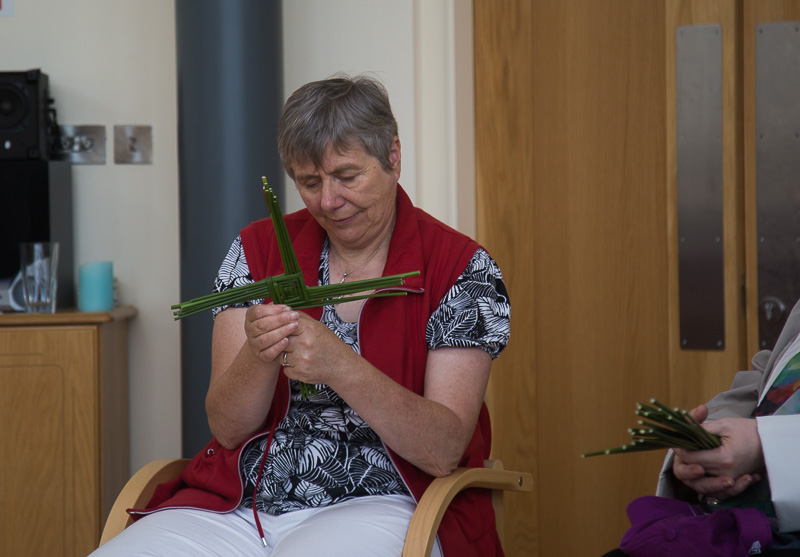
Sr. Phil weaves a St. Brigid’s Cross – Solas Bhride
I can’t think of a better place in Ireland for bringing people together for the first time. After a brief tour of the center, Sister Phil arranged the group in a circle and wove a cross of St. Brigid. With each rush she wove into the cross, she asked the group what they would like to “weave” into their journey this week. As members of this newly formed tour group called out things like friendship, forgiveness, humor, love, respect, St. Phil added a rush to the cross – each rush representing a hope for the journey. At the end she presented me with the cross, and we’ll keep it on the bus in plain sight as a reminder of the blessings received at Solas Bhride…. as we move through these coming days together.

Sr Phil presents the cross to me (Mindie Burgoyne)
The traditional blessing of the St. Brigid’s Cross to be hung in the home is:
“May the blessing of God and the Trinity be on this cross, and on the home where it hangs and on everyone who looks at it”
So we’ll shift that bit and substitute the word “bus” for home and keep at a point of focus on our journey together.
After Solas Bhride (means the light of Brigid), we went around the corner to “Tobar Bride” – St. Brigid’s holy well – a site of local pilgrimage where the water from a holy well runs out to little spring that flows around a small island with a bronze statue of St. Brigid holding a crozier and a flame. (see image above) The peace is palpable in this place.

Clooties on the tree at St. Brigid’s Holy Well – Kildare
There’s a clootie tree by the well (sometimes called fairy tree or rag tree) where pilgrims leave tokens of devotion – something that represents an intention left behind. Today was an interesting array of clooties.
I still believe that every person on our thin places tour was called to that particular tour for a reason. We all have been called to be a collective part of the “whole” that will make up this tour. The first day is always a prayerful time for me. I pray everyone is blessed, inspired, enlightened and celebrated.

Part of our Discover the North 2016 tour group at the welcome dinner in Dublin
So Dan and I welcome you all – Julie, Suzanne, Karen, Richard, Cheryl, Don, Tricia, Anita, Marianne, Kathy, Moyra, Karen, Eleanor, Sally, Jen, Ann, Ruth and Danny.
Here’s to Ireland, new friends, new discoveries and thin places.
The Dark Hedges – County Antrim
 The Dark Hedges refers to an avenue of Beech trees in County Antrim. The trees are now over 200 years old and have become one of the most photographed places in all of Northern Ireland.
The Dark Hedges refers to an avenue of Beech trees in County Antrim. The trees are now over 200 years old and have become one of the most photographed places in all of Northern Ireland.
Planted by the Stuart Family
The trees were planted by the James Stuart, a preacher’s son who was born nearby in 1743. John placed the trees along the drive to his new mansion as an impressive landscape feature. He named the mansion Gracehill House after his beloved wife Grace, a County Tyrone girl who was the daughter of a doctor in Stewartstown. James lived to be 81 years old and had nine children at Gracehill. Of his nine children – his second eldest, William was in the Royal Artillery and died in battle in Barbados. Margaret whose alias was “Cross Peggy” never married and lived until age 89. Elizabeth and Grace were the last two to be born, and they both died young. Gracehill is now a golf course with the manor house as a feature, and the drive is now a public road making the Dark Hedges accessible to photographers and visitors who want to see these amazing trees with their tangled, silvery branches. 
Game of Thrones Connection
The Dark Hedges were also featured in the mini-series Game of Thrones. During the first episode of season two “On the Kings Road” Aya Stark has dressed herself as a boy and escaped Kings Landing. She and others travel the King’s Road to join the Night Watch.
The Grey Lady – Dark Hedges Ghost Story
The Dark Hedges has a ghost story associated with a character referred to only as “the Gray Lady.” At twilight she said to float in and out of the hedges, moving quickly almost as fast as the cars. She’s seen as a shadow – or as a transparent figure – visible to passers-by. She vanishes once the traveler has passed the last beech tree. Some say she’s a spirit from a nearby abandoned graveyard, unrestful now that she’s fallen into the ranks of the unremembered dead. Some say on Halloween night other spirits from that same grave yard join her on her at the Dark Hedges. Me? My money is on it being “Cross Peggy” Stuart, daughter of James Stuart (the builder of the house and the one who planted the trees). Her name appears in several genealogy lists as Margaret “Cross Peggy” Stuart. No explanation. Just the nick-name. That’s reason enough for me. There’s the obvious unanswered question that today’s living want to know. Why were you called “Cross Peggy?”
Close to the Antrim Coast
A bad storm knocked down a few of the beautiful trees this past year, but the grove of beaches and their eerie canopy is still worth seeing and photographing. Regardless of the legends and the ghost story, the Dark Hedges is a worthy side trip for anyone traveling to the Antrim Coast. Perhaps it’s the energy given off by the trees, but there’s a definite thinness about the place. Because it’s close to the Antrim Highway, it’s easy to access for those who are in the area visiting the sites along the coast.
The Dark Hedges is on our Discover the North tour of Ireland.
Top Books to Read on Southwestern Ireland
Here is a list books I found helpful in giving a good overall background of the southwestern region or understanding the sites we’ll be traveling to on the Places of Resurrection tour. Some of them are specifically targeted at mindful travel, making the most of traveling to thin places.
Preparing for Travel to Thin Places
A visit to a mystical site is powerful whether or not you have any understanding of the history or legends associated with that site. But the more understanding you have about a site or about the landscape, the greater the possibility for inner transformation.
Prepare by growing your understanding of earth energy, ancient local traditions and the people of the place and you will be less curious about the facts associated with the site, and more able to absorb the power each site generates. These books are simply suggestions that might help you prepare.
Before you Go – Mindful Travel
Every Ancient, Ever New, by Dolores Whelan – This is a short book with a little over 100 pages, but Dolores gives a solid perspective on how to use the understanding of ancient Celtic traditions to create a new way of seeing the world – of being in the world. This is one of the best books for understanding thin places and what they mean today.
NOTE: The price for this book on Amazon.com fluctuates based on their ability to get the inventory from Ireland. So try ordering directly from Dolores Whalen’s website ($23) of the Amazon price is high.
Ley Lines and Earth Energies, by David Cowan & Chris Arnold – This was the first book I read about the concept of earth energies and how the ancients may have been able to sense those pulsating movements when they built their stone circles, passage tombs and other monuments. We will be doing some dowsing on our tour, so an understanding of this concept will be very helpful.
Awakening to the Spirit World, by Sandra Ingerman & Hank Wesselman – This is one of the best and simplest books on understanding Shamanism and Shamanic practices, which are a way to “journey” to otherworlds in order to gain wisdom. It’s a great primer for understanding the “otherworld” concept and being sensitive to other realms as you move through thin places.
Walking With the Sin Eater, by Ross Heaven – This is a might lighter look at Shamanism and can be read in a few hours. It’s set as a personal memoir of journeying, but reveals some great truths about earth energies and spiritual transformation through journeying.
Region Specific
These books, written by local Irish and travelers to Ireland reveal the hidden landscape, culture, history, folklore and traditions of places in the southwest particularly Dingle, the Aran Island and the Beara Peninsula.
DINGLE
Peig, by Peig Sayers – This is out of print, but you can get used ones from Amazon for a good price. It’s an autobiographical account of a woman who grew on the Dingle peninsula in the early 20th century, but married and moved to the Great Blasket Island and lived a hard life. She only spoke Irish dictated her life’s story to her son who wrote down. It was later translated and is now considered one of the great publications in Irish literature. It also gives insight into the culture and landscape of Dingle, the Blaskets and southwest Ireland in general and the harsh life that formed much of the Irish perspective that we see today.
Twenty Years A-Growing, by Maurice O’Sullivan – First published in 1933, this book, like Pieg is a memoir of O’Sullivan’s life on the great Blasket Island. But this book has a much livelier slant. It’s rich in storytelling, folklore of the southwestern region, and impeccable at describing the landscape and our connection to it.
Climbing Brandon, by Chet Raymo – Raymo is a science writer out of Boston who spent summers on the Dingle. He writes about the holy mountain on Dingle named for St. Brendan the Navigator. His eloquent writing style alone makes the book worth the read, but he gives great insights on the Dingle Peninsula, its legends, culture and the conundrum of making sense of religion with such a strong background in science. His perspective is “in the portal between knowledge and mystery, between the commonplace and the divine.”
THE BEARA PENINSULA
At the Edge of Ireland, by David Yeadon – A travel writer’s perspective of the Beara Peninsula, which is the least traveled of all the southwestern peninsulas. Yeadon and his wife spent time on the Beara and he wrote a funny account of that travel which encompasses everything that is the Beara Peninsula – the villages, the ancient megaliths, the mountains, culture, music, bar scene and more. It’s a comprehensive view of what Leon Uris called “the Terrible Beauty.”
McCarthy’s Bar, by Pete McCarthy – a very fun book written by travel and screen writer Pete McCarthy who traveled from the west coast of Ireland from Cork to Donegal obeying one rule of travel – “Never pass a bar with your name on in.” The cover of this bestselling book shows McCarthy’s Bar in Castletownbere on the Beara. Lots of humor. An entertaining read that reveals the magic of Ireland and its people, but also a good account of the Beara Peninsula and the southwest coast.
THE ARAN ISLANDS
The Aran Islands, by John Millington Synge – Between 1898 and 1901, the great Irish literary figure, John M. Synge traveled to the Aran Islands to observe the landscape and culture of the islanders. This short, little book is a beautiful account of the old folklore, language and traditions that were once at the heart of all of Ireland. One can get a good sense of the Aran Island landscape and people – even the Aran of today by reading this book.
IRELAND IN GENERAL
Legendary Ireland, by Eithne Massey – This book focuses on the myths and legends of Ireland that are associated with places. While several of the sites listed such as the Hag of Beara and Áine of Knockainey but the book itself gives an understanding of how the Irish linked the landscape to the stories, and their perception of a mystical chord that knits that mystical world of myths and legends to our present world.
Let us know your favorite books that reveal the mystical nature of Ireland’s southwestern region including counties Cork, Kerry, Clare and Galway. Put your thoughts in the comments.
Images in the Landscape Tour
The Images in the Landscape tour of thin places in the West of Ireland starts in two days, but the complete journey includes the anticipation that comes before travel when we imagine the journey.
So according to that understanding I am already traveling because I’m full of anticipation.
In 2012, I guided a small group of guests on a 10-day thin places tour in the West of Ireland. One of our stops was Coole Park, the home of Lady Augusta Gregory. She and William Butler Yeats and several others were behind much of the Irish Literary Revival in the early twentieth century. Her manor house is gone now, but the grounds, which include formal gardens, a lake and seven woodlands still appear much as they did when she was there overseeing them.
In 1931 Lady Gregory wrote about the grounds around her home:
“These woods have been well loved, well tended by some who came before me, and my affection has been no less than theirs. The generations of trees have been my care, my comforters. Their companionship has often brought me peace.”
As my tour group entered Coole Park, I overheard a park guide addressing a group of tourists. He said, “You have all now just become an image in an ancient landscape.” I thought about the phrase as I continued to walk. Later, that same phrase became a powerful meditation mantra for me.
How many ancient landscapes do we walk through in this life? And how many times are we are reflective enough to connect with them … to become a part of them … to sense the past that swirls around us?
Claiming that Space Between the Inner and Outer Ancient Landscapes
Since that walk in Coole Park three years ago, I’ve led four group tours to Ireland’s thin places, and today I am getting ready to do another, and we’ll be cycling back to Coole Park. The name for this tour is Images in the Landscape. So now …. a phrase dropped by a tour guide in one little slip of a moment will set the tone for the traveling experience of eighteen people.
We will be visiting Coole Park and its ancient landscape that is reminiscent of when Ireland was covered with hardwoods and deep forests, but we’ll also visit the Burren and its sweeping moonscape of rock and megaliths. We’ll journey out into Lough Corrib, a lake named for the mythical Lord of the Sea. And we’ll land on Inchagoil – Lough Corrib’s most famous island. Inchagoil takes its name from the old Irish words for “Island of the stranger” memorializing a devout man who once lived there.
We’ll wind our way through Connemara and absorb that awesome light while following one of Ireland’s most renowned archeologists, Michael Gibbons on a private tour of Connemara’s hidden landscape. Then we’ll head for Crough Patrick – the holy mountain in County Mayo, and the ruins of Murrisk Abbey at the foot of the mountain. We’ll visit Achill Island, sitting atop a bedrock of amethyst. The island radiates a healing energy while it hypnotizes visitors with its scenic coastline. We’ll walk through the Bricklieve mountains and explore a cluster of passage tombs that pre-date the pyramids of Giza. And we’ll stand on the ancient Hill of Uisneach in the mystical center of Ireland and feel the pull of the magnetic energy there.
The Journey Begins with Anticipation
The journey does not begin when we first arrive at the intended destination. It begins with the anticipation of what will come, of what we will see and learn and experience. Part of that is also worry and fear of the unknown. Travel can be unsettling for some. In looking forward to a journey, we wonder who we will meet, what challenges we’ll face, how we’ll feel once we get there and what the pleasant surprises will be. All of the forethought is part of the journey experience.
The first step in travel – we imagine the journey.
The key learning experiences – the crux of the travel story – the high impact part of the journey – the things that change us are all held in the difference between how we imagine the journey and what the journey actually is. Those differences teach us and change us. Our best memories will be embedded in those differences.
I’m Imagining This Journey
Today I imagine meeting sixteen new friends, and I expect I’ll be changed just a little by each one of them. I look forward to walking up the Hill of Uisneach and touching the Cat Stone and surveying six counties from the summit and feeling that sense of coming home. I’m excited about meeting Michael Gibbons and seeing Connemara through his eyes. I imagine all of things he’ll teach us as we walk that ancient landscape with him. I imagine Inchagoil – and its ruins … and the presence that those ruins still cling to. That will be a new site for me.
I also worry. Worrying about travel is also part of the anticipation. Will the guests get along? Will it rain too much? Will the some of the walking be too difficult for our guests – and how will we handle that? Will the hotels have everything in order? Will I remember everything?
The West of Ireland is Magical
Despite my worries, I know that the “Wow!” moments for the guests on this trip will be remarkable. They’ll never forget the Hill of Uisneach. They’ll be stunned by the raw beauty of Achill Island. They’ll learn so much from our three local guides, Tony Kirby, Michael Gibbons and Mike Croghan. And besides that… I believe no one can drive through Connemara and not be changed. It’s like walking through fairy dust. You’re journeying through several worlds there. So I rest a little knowing that the magical western landscape of Ireland in itself is a jewel that embeds itself in every traveler.
I pray for blessings on Terri, Bob, Linda, Gloria, Bev, Lea, Jim, Maril, John, Karen, Ed, Mary, BJ, Meredith, Bonnie and Renee and safe travel. I pray that John, my excellent coach driver and I will be good leaders and sensitive guides and that on September 20th when this tour is over, our imagined journey will be magnified and expanded by our actual journey and that we will all move forward together.
St. Gobnait’s Holy Well – Ballyvourney

St. Gobnait – image by Patricia Banker
In the early 6th century when Gobnait fled her home in County Clare, she went to Inis Oírr. We don’t know why she fled, only that she believed she would find refuge in the Aran Islands.
Legend states that an angel appeared to her there and told her that her place was not on Inis Oírr, and instructed Gobnait to go on a journey – to seek her true place of resurrection. “Go until you find nine white deer grazing” the angel told her. “It is there that you will find your place of resurrection.”
So Gobnait wandered about the southern coastal counties of Ireland – Waterford, Cork and Kerry – searching.
She saw three white deer in Clondrohid and followed them to Ballymakeera where she saw six more. But it wasn’t until she came to Ballyvourney to a small rise overlooking the River Sullane that she saw the nine white deer all together – grazing … just as the angel from Inis Oírr had prophesied.
She crossed the river and settled there. She founded a religious community for women, performed memorable – some say miraculous works, and it was there she died and was buried.
Thin Places Mystical Tour
St. Gobnait’s shrine and holy well are stops on our Places of Resurrection tour .
DEVOTION TO ST. GOBNAIT
February 11th is St. Gobnait’s feast day -the day her memorable life is celebrated. She is one of the few Irish saints that is not only remembered in her native region, but has been proclaimed by the Irish bishops to be a national saint. There are shrines and places of devotion to St. Gobnait in all the places she is believed to have stopped on her journey – including Inis Oírr. But Ballyvourney, where she carried out most of her ministry, is the place that draws the greatest number of pilgrims devoted to this saint.

Today there is an active church on the former monastic site. St. Gobnait’s grave and marked spots around the churchyard are places where pilgrims pause for devotion and reflection. It is here that they can do the “rounds” or turas, always moving in a clockwise direction – a tradition that has pagan roots.
One of the strongest mystical draws on this site is St. Gobnait’s Holy Well, with its arched entryway that takes the pilgrim into a deeply shaded path. Just next to the well is a sturdy tree, and hanging from it are hundreds of tokens or clooties that have been placed there by pilgrims hoping to leave behind a part of themselves or loved on in need of healing. There are taps and cups available for drinking from the well or for pouring into personal vessels to take holy well water home.

Entrance to St. Gobnait’s Holy Well
St. Gobnait was best known for her care of the sick. There is a legend that tells of her staving off the plague from Ballyvourney by drawing a line in sand with a stick and declaring the village “consecrated ground.” Inside the church today, there is a medieval (possibly 13th century) figure of St. Gobnait which is kept in a drawer. Every year on her feast day, the parish priest brings out the figure to celebrate a devotional tradition. He holds up the ancient figure and the faithful each step forward with a piece of ribbon. They hold the ribbon up and measure it against the length and around the circumference of the figure, then take it home as a blessed relic used for healing or further devotion.
A tall statue of St. Gobnait that was erected in the 1950s stands near the monastic site. She appears with a nun’s habit standing on a bee hive surrounded by bees. Gobnait is the patron saint of bee keepers, and there are several legends recalling Gobnait forcing invaders out of Ballyvourney by setting swarms of bees upon them. It’s probable that Gobnait had a close relationship with bees and used honey in healing efforts.

Statue of St. Gobnait at Ballyvourney
PLACE OF RESURRECTION
Dan and I visited St. Gobnait’s monastic site many years ago. It is indeed, a thin place. The stories of St. Gobnait specifically mention a “place of resurrection.” I heard Dara Molloy use this phrase when referring to his home on Inis Mór and have seen a few authors reference the phrase. But regarding thin places … a place of resurrection is the pinnacle – that place where one’s spirit is totally whole, at home, with no longing or yearning to be anywhere else. A place of resurrection is not only the place where one’s spirit will resurrect from its lifeless body upon death, but also the place where that spirit is most alive inside the living body. And I believe that a place of resurrection is the spiritual home where one is most completely alive and able to create, to discern, to prophesy … to be wise.

Tree at St. Gobnait’s Holy Well – Ballyvourney, Co. Cork
The connection between the eternal world and the physical is nearly unidentifiable in a place of resurrection – as they are knitted together in an inextricable pattern where neither can be separated from the other. The place of resurrection then is unto itself the combination of both worlds particularly suited to that specific spirit. … and Ballyvourney was St. Gobnait’s place.
What is yours?
Image of St. Gobnait courtesy of Patricia Banker; Copyright by Patricia Banker, All Rights Reserved. Used With Permission.
More Books to Read Before Travel to Ireland
Here are more books to read before you travel to Ireland. This is the second post in a series and picks up from the first batch of book suggestions. These books will help you understand the Irish culture, history and landscape. They are especially helpful in discovering more about Irish mythology and the sacred landscape.
Ireland by Frank Delaney
In the winter of 1951, a storyteller, the last practitioner of an honored, centuries-old tradition, arrives at the home of nine-year-old Ronan O’Mara in the Irish countryside. For three wonderful evenings, the old gentleman enthralls his assembled local audience with narratives of foolish kings, fabled saints, and Ireland’s enduring accomplishments before moving on. But these nights change young Ronan forever, setting him on a years-long pursuit of the elusive, itinerant storyteller and the glorious tales that are no less than the saga of his tenacious and extraordinary isle.
Haunted Ground by Erin Hart
When farmers cutting turf in an Irish peat bog make a grisly discovery — the perfectly preserved head of a young woman with long red hair — Irish archaeologist Cormac Maguire and American pathologist Nora Gavin must use cutting-edge techniques to preserve ancient evidence. Because the bog’s watery, acidic environment prevents decay, it’s difficult to tell how long the red-haired girl has been buried — two years, two centuries, or even much longer. Who is she? The extraordinary find leads to even more disturbing puzzles.
Sheela-na-gigs: Unravelling an Enigma by Barbara Freitag
Sheela-na-gig iconic figures depicting wild women displaying their genitalia is found throughout Europe, but very prevalent in Ireland. Here Barbara Freitag examines all the literature on the subject since their discovery 160 years ago, highlighting the inconsistencies of the various interpretations in regard to origin, function and name. By considering the Sheela-na-gigs in their medieval social context, she suggests that they were folk deities with particular responsibility for assistance in childbirth.
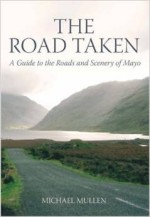 The Road Taken: A Guide to the Roads and Scenery of Mayo
The Road Taken: A Guide to the Roads and Scenery of Mayo
by Michael Mullen
No one can describe the magic of thin places in County Mayo quite like Castlebar native and author, Michael Mullen. From the Nephin Beg range to Achill and the Céide Fields, this study travels through the gentle and rich landscape of Mayo. Author Michael Mullen shares his wide-ranging knowledge of the county in order to give travelers an understanding of Mayo’s rich history and varied landscapes while he guides them along its roads and through its historical and literary heritage. A driving guide, potted history, and miscellany, this is an invaluable companion for anyone wishing to explore the better and lesser-known attractions of the county and includes a beautiful selection of color photographs.
Lion of Ireland by Morgan Llywelyn
King, warrior, and lover Brian Boru was stronger, braver, and wiser than all other men-the greatest king Ireland has ever known. Out of the mists of the country’s most violent age, he merged to lead his people to the peak of their golden era.
Set against the barbaric splendors of the tenth century, this is a story rich in truth and legend-in which friends become deadly enemies, bedrooms turn into battlefields, and dreams of glory are finally fulfilled. Morgan Llywelyn has written one of the greatest novels of Irish history.
In Search of Ancient Ireland, by Carmel McCaffrey
This engaging book traces the history, archaeology, and legends of ancient Ireland from 9000 B.C., when nomadic hunter-gatherers appeared in Ireland at the end of the last Ice Age to 1167 A.D., when a Norman invasion brought the country under control of the English crown for the first time. So much of what people today accept as ancient Irish history—Celtic invaders from Euproe turning Ireland into a Celtic nation; St. Patrick driving the snakes from Ireland and converting its people to Christianity—is myth and legend with little basis in reality. The truth is more interesting. The Irish, as the authors show, are not even Celtic in an archaeological sense. And there were plenty of bishops in Ireland before a British missionary called Patrick arrived. But In Search of Ancient Ireland is not simply the story of events from long ago.
McCarthy’s Bar: A Journey of Discovery In Ireland, Pete McCarthy
Despite the many exotic places Pete McCarthy has visited, he finds that nowhere else can match the particular magic of Ireland, his mother’s homeland. In McCarthy’s Bar, his journey begins in Cork and continues along the west coast to Donegal in the north. Traveling through spectacular landscapes, but at all times obeying the rule, “never pass a bar that has your name on it,” he encounters McCarthy’s bars up and down the land, meeting fascinating people before pleading to be let out at four o’clock in the morning. Written by someone who is at once an insider and an outside, McCarthy’s Bar is a wonderfully funny and affectionate portrait of a rapidly changing country.
Read Books to Read Before You Travel to Ireland and Best Irish Guidebooks
The Mystical Faces of Harry Clarke in Dingle
Harry Clarke – Icons in Stained Glass

Harry Clarke,famous for his stunning stained glass windows scattered all over Ireland, crafted a series of windows depicting the life of Christ that now hang in an obscure chapel in Dingle. To see one Harry Clarke Window is a gift. To see twelve at once is an mystical experience.
The Dingle Peninsula in Ireland’s south west corner is a magical place. Apart from the well-known sites like Slea Head, Gallarus Oratory, the mysterious Blasket Islands, bee hive huts, and Mount Brandon, the Harry Clarke windows in the Chapel of the Sacred Heart at the old convent of the Presentation Sisters are hidden jewels often undiscovered by the traveler who walks the streets of Dingle town.
Perhaps it’s no wonder that Dingle – one of the thinnest places in Ireland – drew unto itself one of the largest collection of Harry Clarke windows installed in a single location.
The windows are housed is a small chapel situated next to St. Mary’s Church on Green Street. Visitors can stop in the An Diseart Visitor Centre and ask for a guided tour, or contact the Centre ahead of time and secure a appointment to view the windows. The young woman who conducted my personal tour explained that this was once a convent and the chapel was solely for the nuns. They were the only beneficiaries of this magnificent art except for on rare occasions.
Illustrator turned Stained Glass Artist
Harry Clarke was the son of a craftsman. He started working with stained glass under his father’s direction when he was in his teens. After he completed his education, Harry Clarke began his professional career as an illustrator. His illustrations adorned books of fairy tales by Hans Christian Andersen and Edgar Allen Poe. It was Clarke’s craftsmanship as an illustrator that set his stained glass windows apart from other famous stained glass artists. The detail to fine lines and his method for using lead to carefully outline his figures was unique. His use color, particularly his shades of blue, made his windows stand apart.
This little chapel next to the grand St. Mary’s Church houses twelve lancet stained glass windows by Harry Clarke. Many churches in Ireland will claim one Harry Clarke window as an element to attract visitors. (And viewing one window IS worth a visit anywhere). But to have twelve all together in one spot is enough to take one’s breath away. Each pair of double windows depicts one of six scenes from the life of Christ – Visit of the Magi, Baptism by John the Baptist, Suffer the Little Children, Sermon on the Mount, Agony in the Garden, and Christ’s Appearance to Mary Magdalene.
The Faces in the Chapel
The faces of Harry Clarke’s characters in theses windows draw the admirer into the work of art – connecting on a deep level. The eyes of the figures follow you as you move around the chapel, and the expressions on the faces are full of emotion. They haunt you after you leave.
The series of windows transports the gazer … lifts the spirit into another realm. They stimulate the imagination.
In 1929, mystical writer George Russell (aka AE) wrote, “Harry Clarke is one of the strangest geniuses of his time … He might have incarnated from the dark side of the moon.” ~The Irish Statesman
Viewing the Harry Clarke Windows at the Diseart Centre
If you’re in Dingle, ask about the Clarke windows. Anyone can direct you to St. Mary’s Catholic Church. The former convent – now theAn Diseart Visitor Centre is next door. Only escorted tours are offered and the hours of operation for the Centre vary so call ahead and inquire about a guided a tour.
The tour takes about and hour and there are beautiful walled gardens as well as a hidden tunnel that can be explored with a guide. But make the chapel the last thing you see, because everything after that will be underwhelming.
The Harry Clarke windows in Dingle are on the Places of Resurrection Tour in 2015
12 Pictures that Will Make You Want to Tour Ireland
Ireland and its thin places have such a draw for those interested in traveling a bit deeper into the landscape. Here are 12 pictures that show some of these amazing places. All of them are on our Castles, Saints & Druids Thin Places tour this September 2014. Join us!
1. The King Oak
The King Oak is said to be between 500-800 years old. It’s part of an ancient oak forest once sacred to the Druids, then later the site of a monastic community. The forest entombs Charleville Castle, a gothic-style castle built from 1798-1812. The King Oak ranked #3 in Europe’s Tree of the Year 2013 and it’s a familiar old spot to the people around Tullamore. Many a romance started and ended beneath the branches of this tree. The spread of the lower branches spread out over 150 feet from end to end. This oak is set in an ancient grove with other trees that are hundreds of years old. When the British invaded Ireland and occupied the country, they ravaged the land, stripping it of all its forests, then exported the wood for profit. Fortunately this oak forest was part of a 1700 acre “gift” from Queen Elizabeth I to the Moore family. The gentry tended to keep the trees on land around their homes. This oak forest has been considered magical for centuries.
2. Charleville Castle
Charleville Castle was built by the Earl of Charleville between 1798 and 1812 in an ancient oak forest near Tullamore. The site was formerly occupied by the Lynally monastic community, and before that was used by the druids for sacred rituals and ceremonies. It is currently owned by a non-profit that uses volunteers from all over the world to help restore the castle and bring it into a self-sustaining existence. The caretaker says that the designers of the castle were Masons and positioned the round towers on crossed ley lines which creates a powerful energy field in the tower rooms. The caretaker also has experienced ghostly sitings that include druids, the Earls of Charleville and the castle designer. Many believe that a little girl named Harriet who was the daughter of the third Earl of Charleville haunts the back staircase where she fell to her death after trying to slide down the bannister. Charleville Castle and its surrounding oak forest is considered one of the scariest places in Ireland.
3. Castleruddery Druid Stone Circle
Castleruddery Stone Circle in County Wicklow is a Bronze Age Druidical circle once used for ritual. There are a total of about 40 stones on the site but the circle itself has about 20 standing stones places on a raised embankment. This would have been a place of great importance based on the geographic layout of the stones, embankment and ditch that is dug outside the embankment. Two large quartz stones mark the portal (entrance) of this circle. Quartz in an amplifier of energy and believed to have healing properties. Some locals from this area believe this stone circle has healing properties. There is also a fairy tree in the circle (pictured here). The roots are wound around a standing stone. Some of the stones have cup marks carved into them and notches carved across.
4. Glendalough
Set in the Wicklow Mountains, Glendalough (meaning valley between two lakes) features the ruins a Medieval monastic city founded by St. Kevin in the 6th century. In the last two centuries it’s been used as a graveyard for local families, but the old bones of the monastic city can still be seen in the hilly landscape. ruins of churches, round-towers, buildings dating from the 9th to 13th century make this site absolutely enchanting. The views of the glen and lakes and babbling stream connecting the lakes are also remarkable. Our Castles, Saints and Druids tour group will be overnighting in the Glendalough Hotel in September.
5. St. Kevin’s Kitchen – Glendalough
St. Kevin’s Kitchen is a 12th century church in Glendalough, and often used as a defining landmark for the ancient monastic city. The church has a stone roof with a round tower built into the roof. Round towers were used for bells, for look-out stations to see people approaching from a distance.
6. St. Berrihert’s Kyle – Glen of Aherlow
St. Berrihert’s Kyle is a round structure built by the local people from pieces of an old monastic ruin. It was made to mark a Cillini or burial ground for unbaptized babies and others not qualified for sanctified ground. The kyle is a complete circle set in an oak grove in the Glen of Aherlow in County Tipperary. Pilgrims travel from all over to pray here. They leave behind devotional tokens – some very rare. These tokens are offerings left in hopes that their prayers will be answered. There is also a holy well (more like a small pond) nearby that is flanked fairy trees covered in clooties, also left by pilgrims.
7. The Rock of Cashel
If the Rock of Cashel doesn’t inspire you, nothing will. This cluster of ruins atop a rocky hill in County Tipperary can be seen for miles. It always reminds me of Emerald City in the Wizard of Oz. The Rock is set in the middle of agricultural land known as the “Golden Veil” because of the bounty of food it produces, and that land is ringed by mountains. The views from the Rock are stunning, and the energy and power of the site radiates in almost fearsome abundance. This is a must-see site in Ireland.
8. The Hill of Tara
This is the Lia Fáil or Stone of Destiny perched atop the Hill of Tara – a corronation site once used for crowning the High Kings of Ireland. An old legend states that if the true High King was crowned, the Lia Fáil would literally cry out or roar. If this stone looks phallic to you, that’s because it’s meant to look that way. The ancient pagans didn’t have the sexual hang-ups of our present world. They believed that male and female were two aspects of the Divine. In this case the stone may represent the male Divine aspect in union with the female aspect (the earth). The stone is believed to have magical properties – those properties were demonstrated the roar of the stone during coronations. The Hill of Tara has a brilliant earth energy.
9. Newgrange Passage Tomb
Newgrange, the Boyne Valley is Ireland’s oldest building remaining fully intact. The tomb dates back 5000 years, predating the pyramids of Egypt, Stonehenge and all the other tombs and prehistoric enclosed structures in Ireland and Britain. Newgrange was a center for spiritual ritual and has remained intact since the Stone Age. The inside is large with a center chamber large enough for 20 people to stand and three side chambers. The entrance is shown in this image (center). Above the opening the tomb is a stone lintel which allows the passage of light to penetrate the pitch blackness of the tomb during the sunrise on the Winter Solstice (December 21) – the shortest day of the year. Visitors to Newgrange can walk deep into the passage tomb and a guide uses an electric light-beam to demonstrate the shift from dark to light during the Solstice sunrise.
10. Sheela-na-Gig – Kildare
There are people who search for Sheela-na-gig’s all over Ireland and in other Celtic countries. These figures are usually primitive carvings in stone that depict a female revealing her genitals with legs spread wide open … usually with some kind of angry face. Some say the Sheelas were fertility goddesses, others believe they a defense against evil or bad energy similar to the function of a gargoyle. They are often found over doorways or beside entryways in churches and castles. Ireland has the most known Sheelas of any country (101). This Sheela-na-gig is hidden under the altar at St. Brigid’s Cathedral in Kildare. As our Thin Places tour group wandered through this beautiful and ancient cathedral, one of the cathedral staff people pointed this out to me. It was tough getting a picture (had to practically lay on the floor), but it was well worth it.
11. Leap Castle
Leap Castle is still being restored by its owner, musician Seán Ryan and his wife. The castle located in County Offaly was built by the O’Bannon clan in the 13th century, and later came under the ownership of the O’Carroll clan. It is said to have been built on a former ceremonial site used by the druids, and archaeologists estimate there has been human habitation on the site since the Iron Age (500 BC). Leap is famous for being haunted, probably because of the violence that has occurred there. The O’Carroll clan, warring over leadership resolved the conflict when one brother (a priest) was saying mass for his gathered family members in the chapel on the upper floor of the tower. Another brother burst through the door and murdered the priest with his sword in front of the family. Thereafter the upper floor of the tower was known as “the Bloody Chapel.” Leap also has an “elemental” or non-human spirit that has been seen as a shadowy figure that makes mischief.
12. Kilkenny – Downtown
While we all love thin places and mystical landscapes, no travel to Ireland is complete until the visitor gets to experience the Irish culture, and Kilkenny is certainly a vibrant town of culture. The name Kilkenny originates from the Irish words that mean Church of Canice and St. Canice’s Cathedral and round tower sitting atop a hill anchors one end of the city while Kilkenny Castle anchors the other. In between are shops, galleries, pubs and heritage sites. This was once a hub for monastic communities. The Grey Friars were here as were the Franciscans – St. Francis Abbey is now home Ireland’s oldest operating brewery which makes Smithwicks and Kilkenny beer. Walking the Kilkenny’s downtown is an excellent way to engage in conversation with the Irish, and the most memorable thing you’ll do on a trip to Ireland is engage with the Irish people.
All of the pictures above and the sites mentioned are part of our Castles, Saints and Druids tour for 2014. It runs from September 11 – 21st. It is a small, specialized tour focused on mystical sites ranging from the ancient druids to the monastic communities through the times of the British occupation. The cost is $2099 per person + airfare. For more details check out the Tour Itinerary.
Glasnevin Cemetery – Memories in Stone
Some believe that stones and trees hold on to the memories of a place. I believe that’s true. The stones in Glasnevin Cemetery in Dublin go on forever. Over 1.5 million people have been buried there since its establishment in 1832, and the markers tell the story of Irish. I went to Glasnevin for those stories. I stayed and was overcome by the art and power of the stones.
Here is a short video featuring some of these remarkable stones.
Glasnevin was established after Daniel O’Connell got legislation passed that allowed Catholics to practice their burial rites and traditions in public. Prior to this, Catholics were oppressed and the “penal laws” prohibited them from the public practice of religious ritual. At Glasnevin, Protestants and Catholics were buried in one place. There was even a place for stillborn children, or children who died before being baptized.
When I planned my trip to Glasnevin, I intended to see the graves of Michael Collins, Eamon de Valera, Brendan Behan, Maud Gonne and Constance Markievicz. My friend Kathy and I spent hours there … not looking for certain graves, but simply looking at grave after grave, stone after stone. The craftsmanship and art in preserving memories and marking places of importance is overwhelming. One loses track of time.
Glasnevin is a thin place.
If you plan a visit to Glasnevin, be prepared to walk and give yourself enough time to wander, to think, to get inside the memories that marked here in gardens of stone that go on forever.
Castleruddery Druid Stone Circle – Wicklow
Castleruddery Stone Circle – also known locally in Wicklow as the “Druid Stone Circle” sits in a clearing at the mouth of the Glen Imaal. Lugnaquilla, the highest peak of the Wicklow Mountain Range is visible in the distance. If I had to pick 3 favorite stone circles out of the scores I’ve visited in Ireland, they would be Uragh, Beaghmore and Castleruddery.
Castleruddery Stone Circle in on our Castles, Saints & Druids tour in September of 2014
There are about 30 stones in this disheveled circle which measures about 100 feet in diameter. Whitethorn trees have grown up in the circle – one actually clutches stones in its roots. Why is this one of my favorites? Energy. There is a an old, ancient energy about Castleruddery. A sensitive person can feel the vibrations from the circle on the approach.
The circle dates back likely to the early Bronze Age (2500 BC), and it has two qualities not typically found together in stone circles –
- It is a recumbent stone circle that follows certain astronomical patterns. Typically these stone were used for ritual practices by the druid class and probably used as a means to chart the seasons.
- The circle is on a ringed embankment with an opening in the east, and aerial views suggest that embankment is on a third embankment. This was a typical setting for building defensive structures – like forts and defensive castles.
Stones outside the circle near the eastern opening of the embankment could be directional stones pointing to the circle – sort of acting like wayside markers.
What we can safely surmise is that Castleruddery Stone Circle was an important place of ritual and probably had a grand entrance.
The Stones of Castleruddery
This circle has the most amazing stones. The most impressive are the portal stones. They are massive white quartz recumbent stones that mark the entryway (east) into the circle. Quartz was significant in druidic circles. It reflected the light rather than absorbing it, and quartz retains energy and absorbs energy from its surrounds.
Local say that Druids still use Castleruddery stone circle for rituals, and that the circle is believed to have healing properties.
Some of the stones in the circle are bullaun stones – stone with cup markings. In the Celtic tradition, these bullauns were created to hold rainwater at a sacred site, and the water collected would have healing properties. There are also stories of locals putting milk (a sign of purity) for the people of the Sidhe in the indentations of bullauns.
But sometimes the circular markings are for other purposes like being indentations to support other circular stones that were used as cursing stones or blessing stones (depending on which way a person turns the stones). In other cases markings on stones – particularly recumbent stones (flat lying stones) – charted an astronomical event like the setting of the sun on a particular day. Carvings could also be directional meant to lead the traveler to a destination.
No one can be certain what the markings on the Castleruddery stones mean. But they are interesting if nothing else.
The Energy of Castleruddery
Ground yourself and calm yourself just before you enter Castleruddery through the quartz portal stones, and you may be able to feel the energy, the vibrations that come through the circle.
Ritual practices ignite energy and also revive it. Energy that is ancient can lie dormant and a stone circle can feel stagnant or dead. But when people come back to a place and practice rituals, they rejuvenate the old energy, calling it back, reigniting what was once there – stirring up the old and mingling it with the new. The circle feels like it once did – vibrating with energy.
This is how Castleruddery feels to me. The strong vibrational pull is similar to Cashelkeelty or Uragh in West Cork and Beaghmore in Tyrone or Caldragh in Fermanagh (even though Caldragh is not a stone circle but the home of the Boa Island Janus figures). There is a magic about the stones.
The name Castleruddery comes from the Irish Caisleán an Ridire meaning Castle of the Knight.
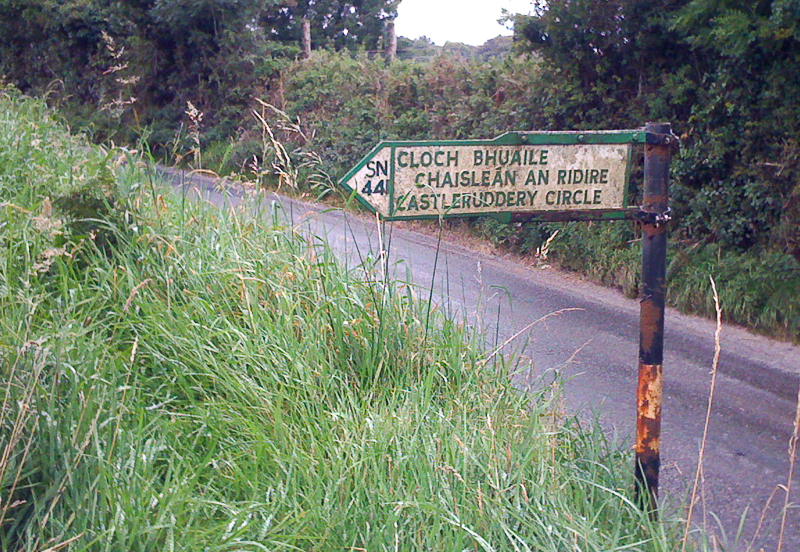 Castleruddery Stone Circle in on our Castles, Saints & Druids tour in September of 2014
Castleruddery Stone Circle in on our Castles, Saints & Druids tour in September of 2014





